pH-Dependent Metabolic Regulation in Clostridium ljungdahlii During CO Fermentation
Abstract
1. Introduction
2. Materials and Methods
2.1. Strains and Culture Medium
2.2. Fed-Batch Fermentation with CO
2.3. Carbon and Energy Flux Analysis
2.4. Comparative Proteomics Analysis
2.5. Parallel Reaction Monitoring (PRM) Analysis
2.6. Analytical Methods
3. Results and Discussion
3.1. Fed-Batch Fermentation in CO Fermentation with pH Control
3.2. Quantitative Proteome Analyses of C. ljungdahlii Cells in CO Fermentation
3.3. PRM Quantification of 25 Key Enzymes in C. ljungdahlii CO Fermentation
3.4. Optimal pH for the Growth and Metabolism in CO Fermentation
4. Conclusions
Supplementary Materials
Author Contributions
Funding
Institutional Review Board Statement
Informed Consent Statement
Data Availability Statement
Conflicts of Interest
References
- Henstra, A.M.; Sipma, J.; Rinzema, A.; Stams, A.J.M. Microbiology of synthesis gas fermentation for biofuel production. Curr. Opin. Biotech. 2007, 18, 200–206. [Google Scholar] [CrossRef] [PubMed]
- Köpke, M.; Held, C.; Hujer, S.; Liesegang, H.; Wiezer, A.; Wollherr, A.; Ehrenreich, A.; Liebl, W.; Gottschalk, G.; Dürre, P. Clostridium ljungdahlii represents a microbial production platform based on syngas. Proc. Natl. Acad. Sci. USA 2010, 107, 13087–13092. [Google Scholar] [CrossRef]
- Liew, F.; Henstra, A.M.; Winzer, K.; Köpke, M.; Simpson, S.D.; Minton, N.P. Insights into CO2 fixation pathway of by targeted mutagenesis. mBio 2016, 7, e00427-16. [Google Scholar] [CrossRef] [PubMed]
- Köpke, M.; Mihalcea, C.; Liew, F.M.; Tizard, J.H.; Ali, M.S.; Conolly, J.J.; Al-Sinawi, B.; Simpson, S.D. 2,3-butanediol production by acetogenic bacteria, an alternative route to chemical synthesis, using industrial waste gas. Appl. Environ. Microbiol. 2011, 77, 5467–5475. [Google Scholar] [CrossRef]
- Jones, S.W.; Fast, A.G.; Carlson, E.D.; Wiedel, C.A.; Au, J.; Antoniewicz, M.R.; Papoutsakis, E.T.; Tracy, B.P. CO2 fixation by anaerobic non-photosynthetic mixotrophy for improved carbon conversion. Nat. Commun. 2016, 7, 12800. [Google Scholar] [CrossRef]
- Marcellin, E.; Behrendorff, J.B.; Nagaraju, S.; DeTissera, S.; Segovia, S.; Palfreyman, R.W.; Daniell, J.; Licona-Cassani, C.; Quek, L.E.; Speight, R.; et al. Low carbon fuels and commodity chemicals from waste gases-systematic approach to understand energy metabolism in a model acetogen. Green Chem. 2016, 18, 3020–3028. [Google Scholar] [CrossRef]
- Liew, F.E.; Nogle, R.; Abdalla, T.; Rasor, B.J.; Canter, C.; Jensen, R.O.; Wang, L.; Strutz, J.; Chirania, P.; De Tissera, S.; et al. Carbon-negative production of acetone and isopropanol by gas fermentation at industrial pilot scale. Nat. Biotechnol. 2022, 40, 335–344. [Google Scholar] [CrossRef]
- Drake, H.L.; Gössner, A.S.; Daniel, S.L. Old acetogens, new light. Ann. N. Y. Acad. Sci. 2008, 1125, 100–128. [Google Scholar] [CrossRef]
- Ragsdale, S.W. Enzymology of the Wood-Ljungdahl pathway of acetogenesis. Ann. N. Y. Acad. Sci. 2008, 1125, 129–136. [Google Scholar] [CrossRef]
- Fackler, N.; Heijstra, B.D.; Rasor, B.J.; Brown, H.; Martin, J.; Ni, Z.F.; Shebek, K.M.; Rosin, R.R.; Simpson, S.D.; Tyo, K.E.; et al. Stepping on the gas to a circular economy: Accelerating development of carbon-negative chemical production from gas fermentation. Annu. Rev. Chem. Biomol. 2021, 12, 439–470. [Google Scholar] [CrossRef]
- Schuchmann, K.; Müller, V. Autotrophy at the thermodynamic limit of life: A model for energy conservation in acetogenic bacteria. Nat. Rev. Microbiol. 2014, 12, 809–821. [Google Scholar] [CrossRef] [PubMed]
- Wiechmann, A.; Müller, V. Energy Conservation in the Acetogenic Bacterium. Microorganisms 2021, 9, 258. [Google Scholar] [CrossRef]
- Kremp, F.; Roth, J.; Müler, V. A third way of energy conservation in acetogenic bacteria. Microbiol. Spectr. 2022, 10, e01385-22. [Google Scholar] [CrossRef] [PubMed]
- Ljungdahl, L.G. The autotrophic pathway of acetate synthesis in acetogenic bacteria. Annu. Rev. Microbiol. 1986, 40, 415–450. [Google Scholar] [CrossRef]
- Doukov, T.I.; Iverson, T.M.; Seravalli, J.; Ragsdale, S.W.; Drennan, C.L. A Ni-Fe-Cu center in a bifunctional carbon monoxide dehydrogenase/acetyl-CoA synthase. Science 2002, 298, 567–572. [Google Scholar] [CrossRef] [PubMed]
- Yin, M.D.; Lemaire, O.N.; Rosas Jimenez, J.G.; Belhamri, M.; Shevchenko, A.; Hummer, G.; Wagner, T.; Murphy, B.J. Conformational dynamics of a multienzyme complex in anaerobic carbon fixation. Science 2025, 387, 498–504. [Google Scholar] [CrossRef]
- Tremblay, P.L.; Zhang, T.; Dar, S.A.; Leang, C.; Lovley, D.R. The Rnf complex of Clostridium ljungdahlii is a proton-translocating ferredoxin:NAD+ oxidoreductase essential for autotrophic growth. Mbio 2013, 4, e00406-12. [Google Scholar] [CrossRef]
- Wang, S.N.; Huang, H.Y.; Kahnt, J.; Mueller, A.P.; Köpke, M.; Thauer, R.K. NADP-specific electron-bifurcating [FeFe]-hydrogenase in a functional complex with formate dehydrogenase in Clostridium autoethanogenum grown on CO. J. Bacteriol. 2013, 195, 4373–4386. [Google Scholar] [CrossRef]
- Zhu, H.F.; Liu, Z.Y.; Zhou, X.; Yi, J.H.; Lun, Z.M.; Wang, S.N.; Tang, W.Z.; Li, F.L. Energy conservation and carbon flux distribution during fermentation of CO or H2/CO2 by Clostridium ljungdahlii. Front. Microbiol. 2020, 11, 416. [Google Scholar] [CrossRef]
- Yi, J.H.; Huang, H.Y.; Liang, J.Y.; Wang, R.F.; Liu, Z.Y.; Li, F.L.; Wang, S.N. A heterodimeric reduced-ferredoxin-dependent methylenetetrahydrofolate reductase from syngas-fermenting Clostridium ljungdahlii. Microbiol. Spectr. 2021, 9, e0095821. [Google Scholar] [CrossRef]
- Mock, J.; Wang, S.N.; Huang, H.Y.; Kahnt, J.; Thauer, R.K. Evidence for a hexaheteromeric methylenetetrahydrofolate reductase in Moorella thermoacetica. J. Bacteriol. 2014, 196, 3303–3314. [Google Scholar] [CrossRef] [PubMed]
- Öppinger, C.; Kremp, F.; Müller, V. Is reduced ferredoxin the physiological electron donor for MetVF-type methylenetetrahydrofolate reductases in acetogenesis? A hypothesis. Int. Microbiol. 2022, 25, 75–88. [Google Scholar] [CrossRef] [PubMed]
- Müller, V. Energy conservation in acetogenic bacteria. Appl. Environ. Microbiol. 2003, 69, 6345–6353. [Google Scholar] [CrossRef] [PubMed]
- Rosenbaum, F.P.; Müller, V. Energy conservation under extreme energy limitation: The role of cytochromes and quinones in acetogenic bacteria. Extremophiles 2021, 25, 413–424. [Google Scholar] [CrossRef]
- Liu, Z.Y.; Jia, D.C.; Zhang, K.D.; Zhu, H.F.; Zhang, Q.; Jiang, W.H.; Gu, Y.; Li, F.L. Ethanol metabolism dynamics in Clostridium ljungdahlii grown on carbon monoxide. Appl. Environ. Microbiol. 2020, 86, e00730-20. [Google Scholar] [CrossRef]
- Liew, F.; Henstra, A.M.; Köpke, M.; Winzer, K.; Simpson, S.D.; Minton, N.P. Metabolic engineering of Clostridium autoethanogenum for selective alcohol production. Metab. Eng. 2017, 40, 104–114. [Google Scholar] [CrossRef]
- Lubner, C.E.; Jennings, D.P.; Mulder, D.W.; Schut, G.J.; Zadvornyy, O.A.; Hoben, J.P.; Tokmina-Lukaszewska, M.; Berry, L.; Nguyen, D.M.; Lipscomb, G.L.; et al. Mechanistic insights into energy conservation by flavin-based electron bifurcation. Nat. Chem. Biol. 2017, 13, 655–659. [Google Scholar] [CrossRef]
- Peters, J.W.; Miller, A.F.; Jones, A.K.; King, P.W.; Adams, M.W.W. Electron bifurcation. Curr. Opin. Chem. Biol. 2016, 31, 146–152. [Google Scholar] [CrossRef]
- Yang, Y.J.; Qiao, K.Y.; Yu, Y.R.; Zong, Y.M.; Liu, C.; Li, Y. Unravelling potential biomarkers for acute and chronic brucellosis through proteomic and bioinformatic approaches. Front. Cell. Infect. Microbiol. 2023, 13, 1216176. [Google Scholar] [CrossRef]
- Sun, H.L.; Luan, G.D.; Ma, Y.F.; Lou, W.J.; Chen, R.Z.; Feng, D.D.; Zhang, S.S.; Sun, J.H.; Lu, X.F. Engineered hypermutation adapts cyanobacterial photosynthesis to combined high light and high temperature stress. Nat. Commun. 2023, 14, 1238. [Google Scholar] [CrossRef]
- Tanner, R.S.; Miller, L.M.; Yang, D. Clostridium ljungdahlii sp. nov., an acetogenic species in clostridial rRNA homology group I. Int. J. Syst. Bacteriol. 1993, 43, 232–236. [Google Scholar] [CrossRef]
- Xie, B.T.; Liu, Z.Y.; Tian, L.; Li, F.L.; Chen, X.H. Physiological response of Clostridium ljungdahlii DSM 13528 of ethanol production under different fermentation conditions. Bioresour. Technol. 2015, 177, 302–307. [Google Scholar] [CrossRef] [PubMed]
- Moon, H.G.; Jang, Y.S.; Cho, C.; Lee, J.; Binkley, R.; Lee, S.Y. One hundred years of clostridial butanol fermentation. FEMS Microbiol. Lett. 2016, 363, fnw001. [Google Scholar] [CrossRef] [PubMed]
- Lütke-Eversloh, T.; Bahl, H. Metabolic engineering of Clostridium acetobutylicum: Recent advances to improve butanol production. Curr. Opin. Biotech. 2011, 22, 634–647. [Google Scholar] [CrossRef] [PubMed]
- Tan, Y.; Liu, Z.Y.; Liu, Z.; Li, F.L. Characterization of an acetoin reductase/2,3-butanediol dehydrogenase from Clostridium ljungdahlii DSM 13528. Enzym. Microb. Technol. 2015, 79–80, 1–7. [Google Scholar] [CrossRef]
- Valgepea, K.; Loi, K.Q.; Behrendorff, J.B.; Lemgruber, R.D.P.; Plan, M.; Hodson, M.P.; Köpke, M.; Nielsen, L.K.; Marcellin, E. Arginine deiminase pathway provides ATP and boosts growth of the gas-fermenting acetogen. Metab. Eng. 2017, 41, 202–211. [Google Scholar] [CrossRef]
- Valgepea, K.; Lemgruber, R.D.P.; Abdalla, T.; Binos, S.; Takemori, N.; Takemori, A.; Tanaka, Y.; Tappel, R.; Köpke, M.; Simpson, S.D.; et al. H2 drives metabolic rearrangements in gas-fermenting. Biotechnol. Biofuels 2018, 11, 55. [Google Scholar] [CrossRef]
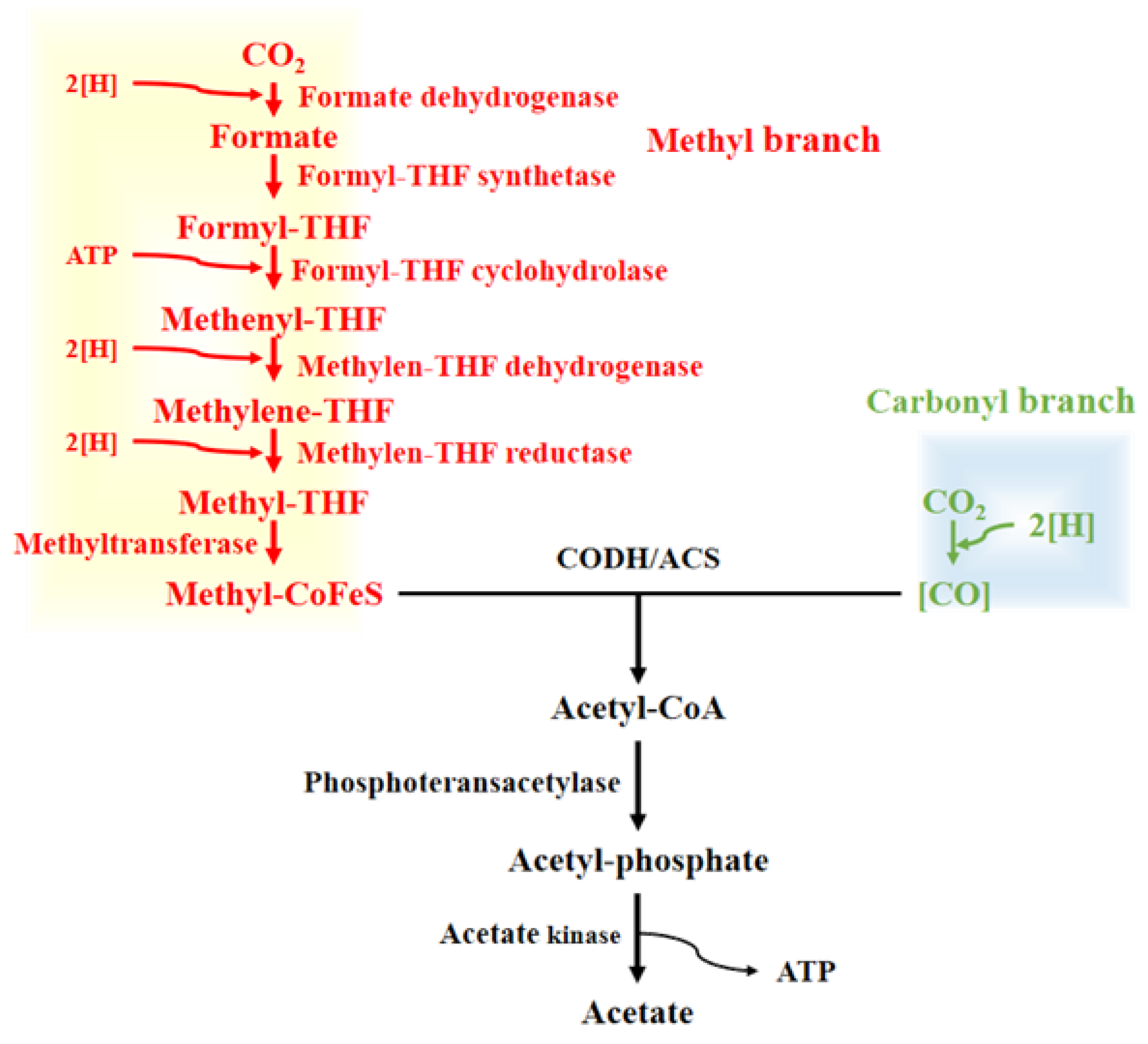
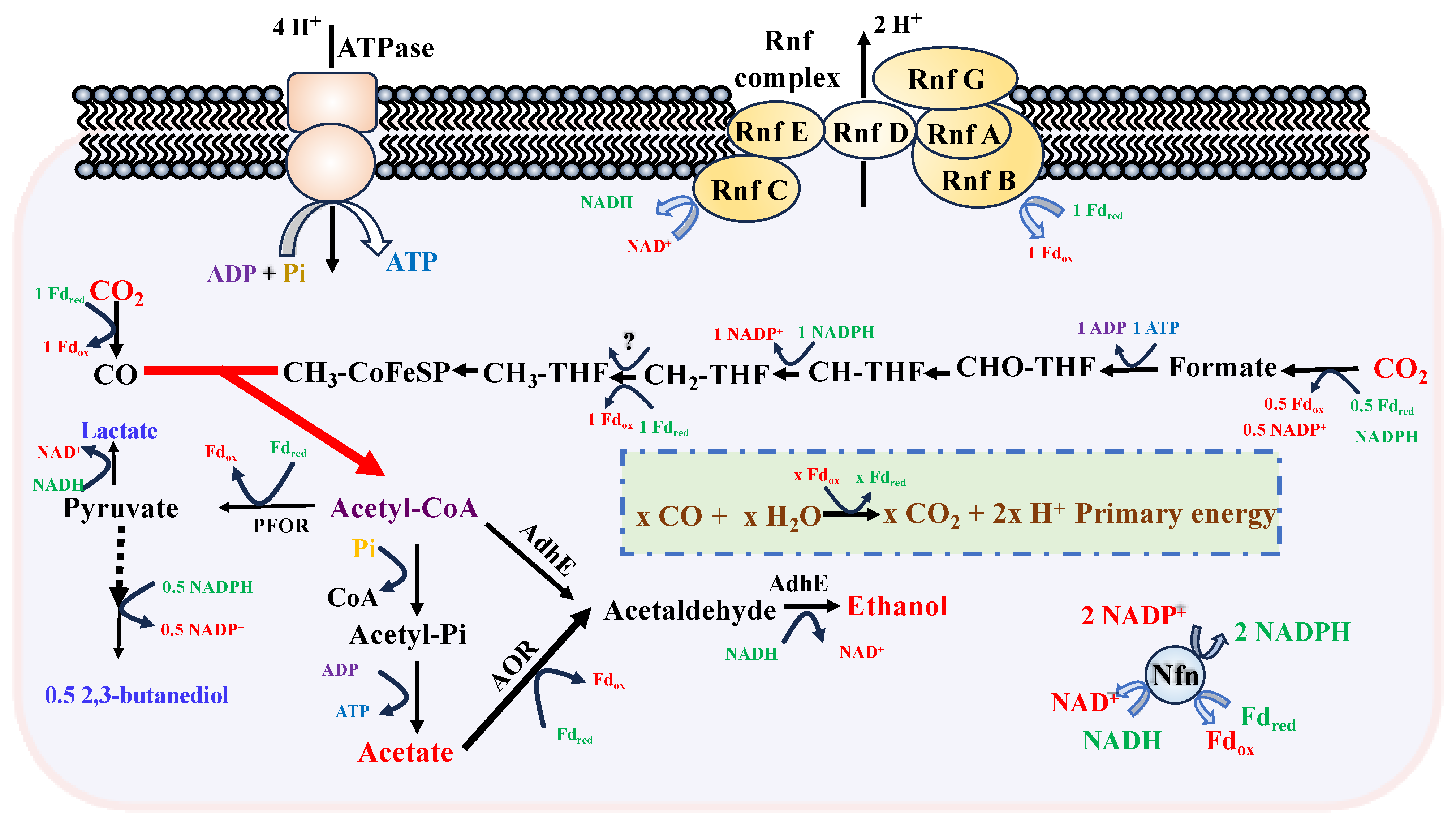


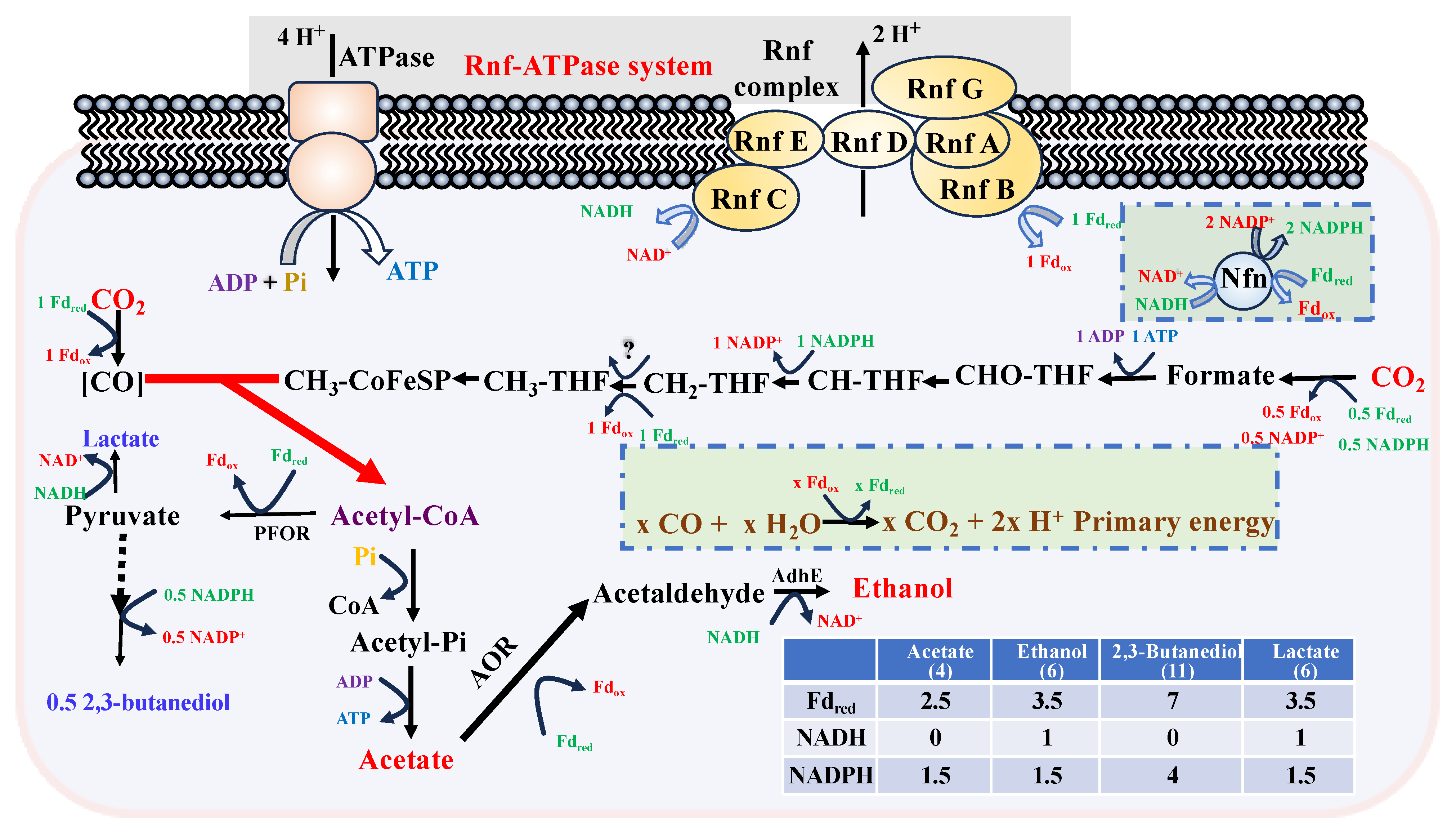
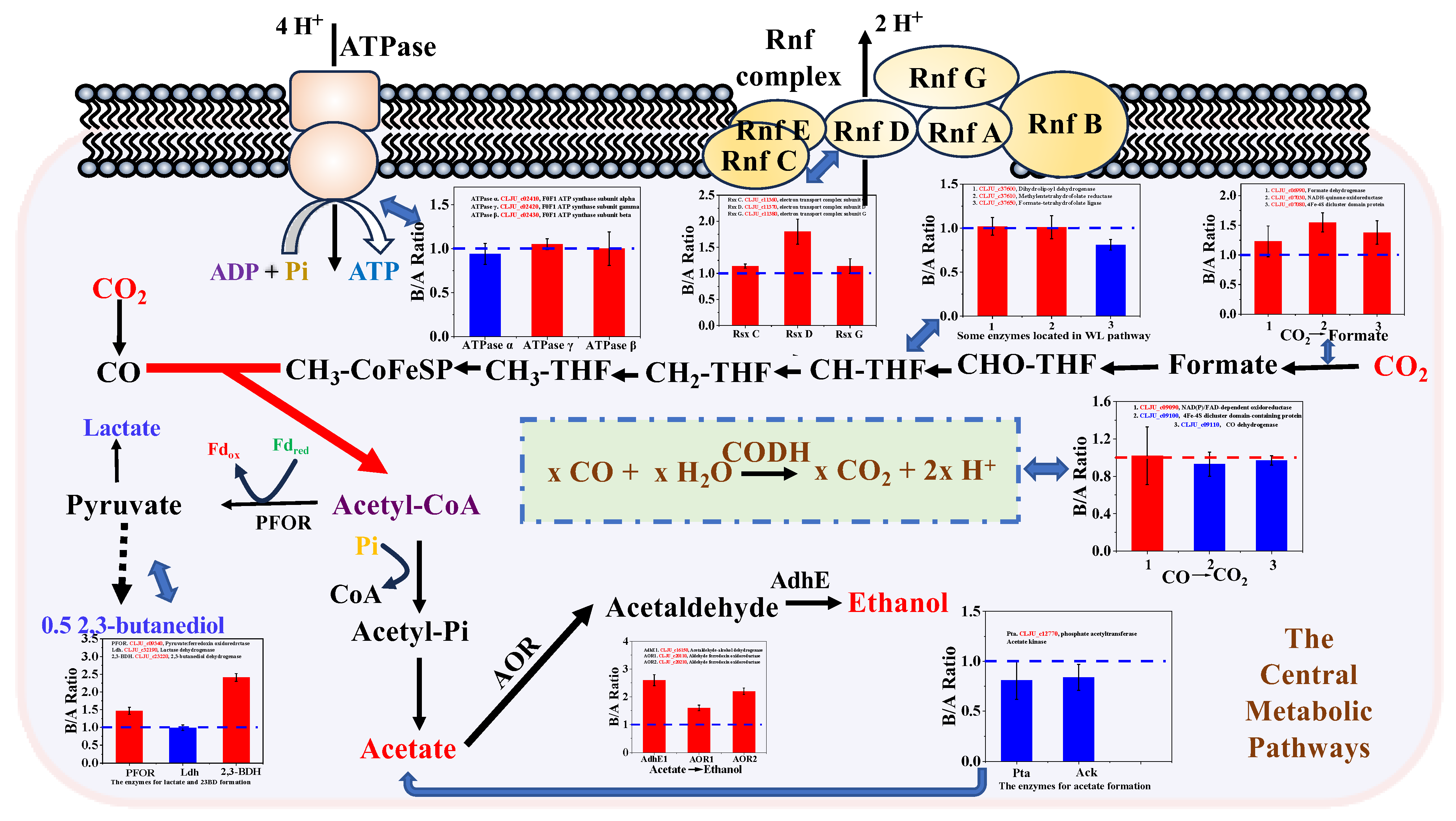
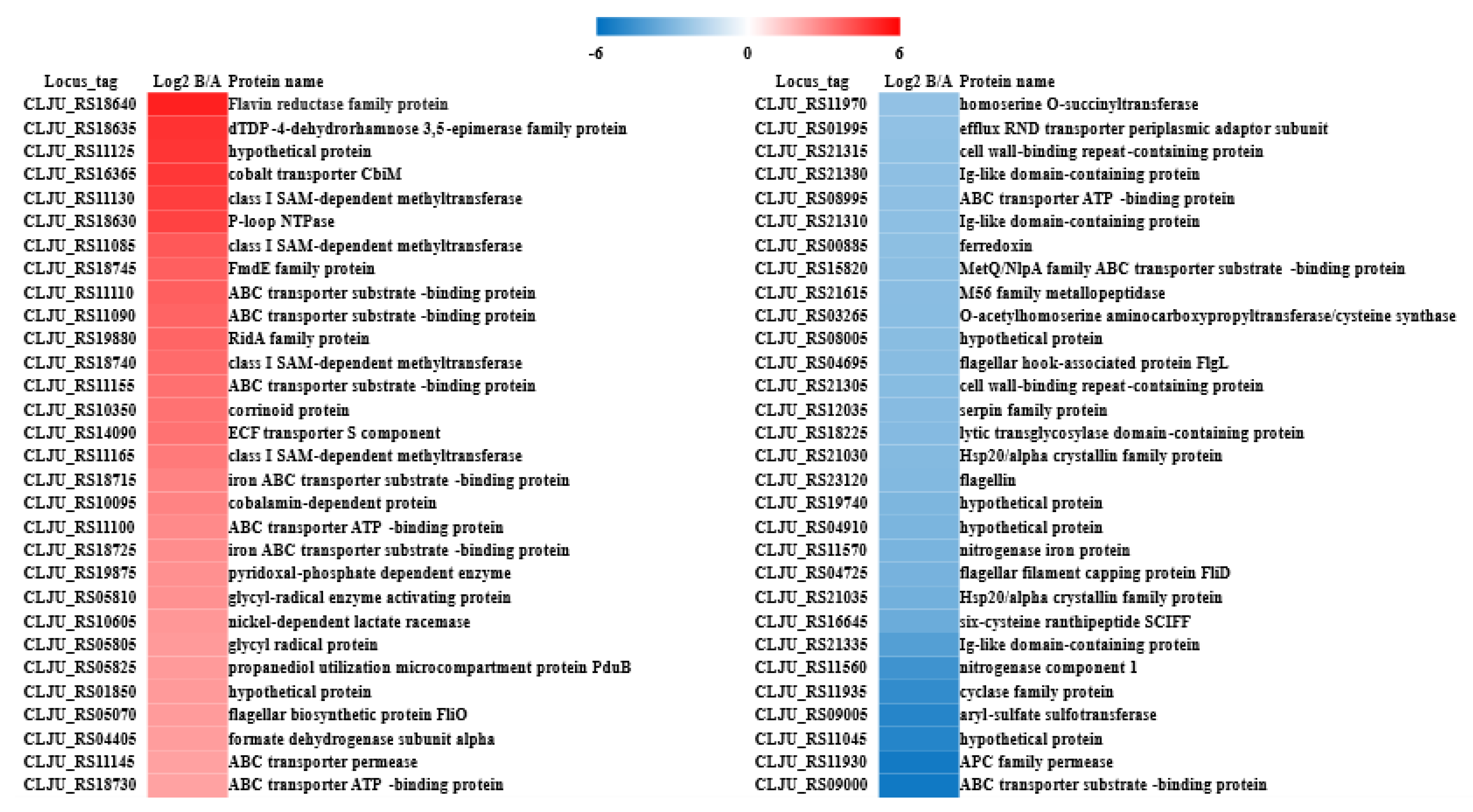

| Biochemical Reactions | Gene Locus | Enzymes/Enzyme Complex | Intensity a | Change Fold b | |
|---|---|---|---|---|---|
| CO pH 6.0 | CO pH 5.3 | ||||
| CO↔CO2 | CLJU_RS04490/ CLJU_c09110 | cooS, carbon-monoxide dehydrogenase catalytic subunit | 0.14 | 0.13 | 1.1 |
| CO2↔Formate | CLJU_RS03440/CLJU_c06990 | fdh1, formate dehydrogenase H subunit alpha | 0.05 | 0.065 | 0.8 |
| CLJU_RS03455/CLJU_c07020 | Sulfurtransferase FdhD | 0.045 | 0.02 | 2.3 | |
| CLJU_RS03460/CLJU_c07030 | NADH-quinone oxidoreductase subunit NuoE | 1.35 | 0.6 | 2.3 | |
| CLJU_RS03470/CLJU_c07050 | 2Fe-2S cluster binding domain-containing protein | 5.95 | 3.55 | 1.7 | |
| CLJU_RS03475/CLJU_c07060 | 4Fe-4S dicluster domain-containing protein | 8.7 | 4.85 | 1.8 | |
| Formate↔ Acetyl-CoA | CLJU_RS18495/ CLJU_c37560 | carbon monoxide dehydrogenase | 13.2 | 9.3 | 1.4 |
| CLJU_RS18500/ CLJU_c37570 | acetyl-CoA synthase /synthase complex subunit gamma | 5.2 | 4.9 | 1.1 | |
| CLJU_RS18540/ CLJU_c37650 | fhs, formate-tetrahydrofolate ligase | 2.7 | 3.1 | 0.9 | |
| CLJU_RS18550/ CLJU_c37670 | cooS, carbon-monoxide dehydrogenase catalytic subunit | 6.8 | 7.7 | 0.9 | |
| Acetyl-CoA↔ Acetaldehyde↔ Ethanol | CLJU_RS08095/CLJU_c16510 | adhE1, bifunctional acetaldehyde-CoA/alcohol dehydrogenase | 0.22 | 0.135 | 1.6 |
| CLJU_RS08100/CLJU_c16520 | adhE2, bifunctional acetaldehyde-CoA/alcohol dehydrogenase | ND | ND | --- | |
| Acetate↔ Acetaldehyde | CLJU_RS09865/CLJU_c20110 | aor1, aldehyde ferredoxin oxidoreductase | 5.7 | 2.9 | 2.0 |
| CLJU_RS09915/CLJU_c20210 | aor2, aldehyde ferredoxin oxidoreductase | 6.0 | 1.6 | 3.8 | |
| Acetyl-CoA↔ Acetate | CLJU_RS06260/CLJU_c12770 | pta, phosphate acetyltransferase | 7.8 | 8.7 | 0.9 |
| CLJU_RS06265/CLJU_c12780 | ack, acetate kinase | 3.8 | 5.1 | 0.7 | |
| Acetyl-CoA↔ Pyruvate↔ Lactate or 2,3-butanediol | CLJU_RS04605/CLJU_c09340 | pfor, pyruvate:ferredoxin oxidoreductase | 5.6 | 2.9 | 1.9 |
| CLJU_RS15865/CLJU_c32190 | ldhA, lactate dehydrogenase | 0.25 | 0.15 | 1.7 | |
| CLJU_RS11425/CLJU_c23220 | 2,3-bdh, 2,3-butanediol dehydrogenase | 2.6 | 0.8 | 3.3 | |
| Energy conservation metabolic pathway genes | |||||
| ATPase system | CLJU_RS01170/CLJU_c02390 | atpF, ATP synthase F0 subunit B | 1.2 | 1.2 | 1.0 |
| CLJU_RS01175/CLJU_c02400 | F0F1 ATP synthase subunit delta | 1.07 | 1.05 | 1.0 | |
| CLJU_RS01180/CLJU_c02410 | F0F1 ATP synthase subunit alpha | 5.4 | 4.2 | 1.3 | |
| Rnf Complex | CLJU_RS05570/CLJU_c11360 | rnfC, type electron transport complex subunit, Rnf C | 1.2 | 1.1 | 1.1 |
| CLJU_RS05575/CLJU_c11370 | rnfD, NADH:ubiquinone oxidoreductase, Rnf D | 3.3 | 2.7 | 1.2 | |
| CLJU_RS05580/CLJU_c11380 | rnfG, FMN-binding protein, Rnf G | 5.1 | 3.4 | 1.5 | |
Disclaimer/Publisher’s Note: The statements, opinions and data contained in all publications are solely those of the individual author(s) and contributor(s) and not of MDPI and/or the editor(s). MDPI and/or the editor(s) disclaim responsibility for any injury to people or property resulting from any ideas, methods, instructions or products referred to in the content. |
© 2025 by the authors. Licensee MDPI, Basel, Switzerland. This article is an open access article distributed under the terms and conditions of the Creative Commons Attribution (CC BY) license (https://creativecommons.org/licenses/by/4.0/).
Share and Cite
Liu, Z.-R.; Wen, Z.-Q.; Wu, J.-W.; Gao, H.-P.; Zhang, Q.; Li, L.-P.; Liu, L.-C.; Li, Q.; Li, F.-L.; Liu, Z.-Y. pH-Dependent Metabolic Regulation in Clostridium ljungdahlii During CO Fermentation. Fermentation 2025, 11, 154. https://doi.org/10.3390/fermentation11030154
Liu Z-R, Wen Z-Q, Wu J-W, Gao H-P, Zhang Q, Li L-P, Liu L-C, Li Q, Li F-L, Liu Z-Y. pH-Dependent Metabolic Regulation in Clostridium ljungdahlii During CO Fermentation. Fermentation. 2025; 11(3):154. https://doi.org/10.3390/fermentation11030154
Chicago/Turabian StyleLiu, Ze-Rong, Zhi-Qiong Wen, Jing-Wen Wu, Hui-Peng Gao, Quan Zhang, Lan-Peng Li, Li-Cheng Liu, Qiang Li, Fu-Li Li, and Zi-Yong Liu. 2025. "pH-Dependent Metabolic Regulation in Clostridium ljungdahlii During CO Fermentation" Fermentation 11, no. 3: 154. https://doi.org/10.3390/fermentation11030154
APA StyleLiu, Z.-R., Wen, Z.-Q., Wu, J.-W., Gao, H.-P., Zhang, Q., Li, L.-P., Liu, L.-C., Li, Q., Li, F.-L., & Liu, Z.-Y. (2025). pH-Dependent Metabolic Regulation in Clostridium ljungdahlii During CO Fermentation. Fermentation, 11(3), 154. https://doi.org/10.3390/fermentation11030154





